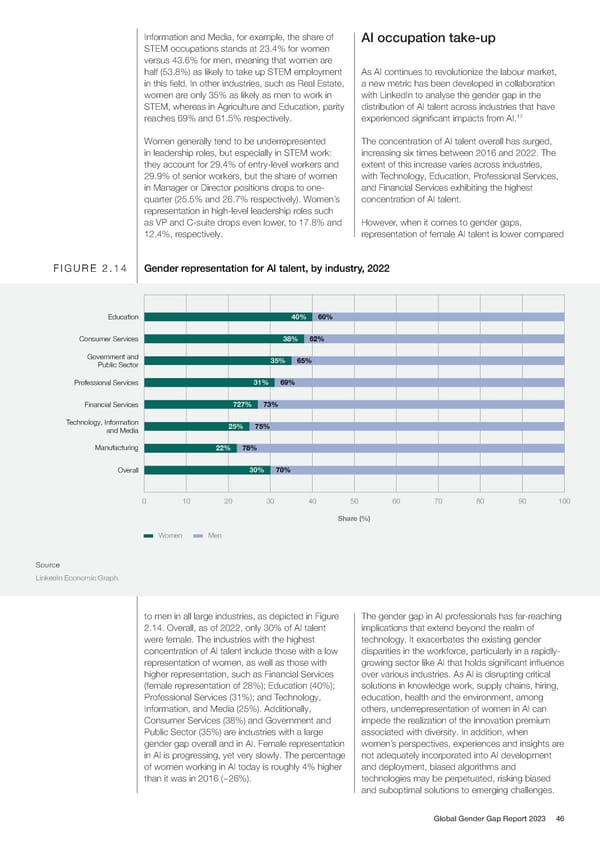Information and Media, for example, the share of AI occupation take-up STEM occupations stands at 23.4% for women versus 43.6% for men, meaning that women are half (53.8%) as likely to take up STEM employment As AI continues to revolutionize the labour market, in this 昀椀eld. In other industries, such as Real Estate, a new metric has been developed in collaboration women are only 35% as likely as men to work in with LinkedIn to analyse the gender gap in the STEM, whereas in Agriculture and Education, parity distribution of AI talent across industries that have 17 reaches 69% and 61.5% respectively. experienced signi昀椀cant impacts from AI. Women generally tend to be underrepresented The concentration of AI talent overall has surged, in leadership roles, but especially in STEM work: increasing six times between 2016 and 2022. The they account for 29.4% of entry-level workers and extent of this increase varies across industries, 29.9% of senior workers, but the share of women with Technology, Education, Professional Services, in Manager or Director positions drops to one- and Financial Services exhibiting the highest quarter (25.5% and 26.7% respectively). Women’s concentration of AI talent. representation in high-level leadership roles such as VP and C-suite drops even lower, to 17.8% and However, when it comes to gender gaps, 12.4%, respectively. representation of female AI talent is lower compared FIGURE 2.14 Gender representation for AI talent, by industry, 2022 Education 40% 60% Consumer Services 38% 62% Government and 35% 65% Public Sector Professional Services 31% 69% Financial Services 727% 73% Technology, Information 25% 75% and Media Manufacturing 22% 78% Overall 30% 70% 0 10 20 30 40 50 60 70 80 90 100 Share (%) Women Men Source LinkedIn Economic Graph. to men in all large industries, as depicted in Figure The gender gap in AI professionals has far-reaching 2.14. Overall, as of 2022, only 30% of AI talent implications that extend beyond the realm of were female. The industries with the highest technology. It exacerbates the existing gender concentration of AI talent include those with a low disparities in the workforce, particularly in a rapidly- representation of women, as well as those with growing sector like AI that holds signi昀椀cant in昀氀uence higher representation, such as Financial Services over various industries. As AI is disrupting critical (female representation of 28%); Education (40%); solutions in knowledge work, supply chains, hiring, Professional Services (31%); and Technology, education, health and the environment, among Information, and Media (25%). Additionally, others, underrepresentation of women in AI can Consumer Services (38%) and Government and impede the realization of the innovation premium Public Sector (35%) are industries with a large associated with diversity. In addition, when gender gap overall and in AI. Female representation women’s perspectives, experiences and insights are in AI is progressing, yet very slowly. The percentage not adequately incorporated into AI development of women working in AI today is roughly 4% higher and deployment, biased algorithms and than it was in 2016 (~26%). technologies may be perpetuated, risking biased and suboptimal solutions to emerging challenges. Global Gender Gap Report 2023 46
 Global Gender Gap Report 2023 Page 45 Page 47
Global Gender Gap Report 2023 Page 45 Page 47